Ducks typically require less extensive housing than chickens and other poultry. Ducks are adaptable to the weather and will thrive providing they are not exposed to prolonged periods of harsh conditions. They thrive well outdoors, given that they have their own open enclosure and are safe from predators at night.
Good quality feed that is fresh, free of mold and insect damage and properly balance for nutrients is essential. Commercial feed processors can blend excellent rations. Crumbles or pellets are preferred over meal because ducks tend to choke on the powdery form of feed.
Though swimming water is good exercise and is entertaining, it is not essential for growing ducks. Pools or small ponds can become soiled quickly and if not flushed often the rank water can be detrimental. Ducks will stay clean and healthy with adequately adjusted drip-type watering systems and wire floors. Fresh drinking water is essential for top performance.
Source of Commercial Ducklings
Catalog hatcheries typically sell quality commercial hybrid Pekin ducklings. Some hatcheries provide ducklings through local feed mills and deliver them on scheduled “Chick Days.” Ask the supplier the specific hybrid they sell. If they can’t tell you, chances are the ducklings are not hybrids and will lack the uniformity and commercial qualities that true hybrids have.
Though Rouen or Mallard colored ducklings are attractive and can be used for meat or eggs, they grow much slower and are less feed efficient than hybrid commercial ducklings. If the ducks are raised for a county fair meat class, the colored ducks will not be competitive in their class. If they are raised for a niche market, they often dress out with dark pin feathers and will be undesirable to the consumer.
Quality hybrid ducks that meet the commercial market cost less to raise than non-hybrids, so it would be advisable to grow the best ducks that you can. Calculate back seven weeks from your fair to determine the hatch date for your ducklings!
Brooding Ducklings
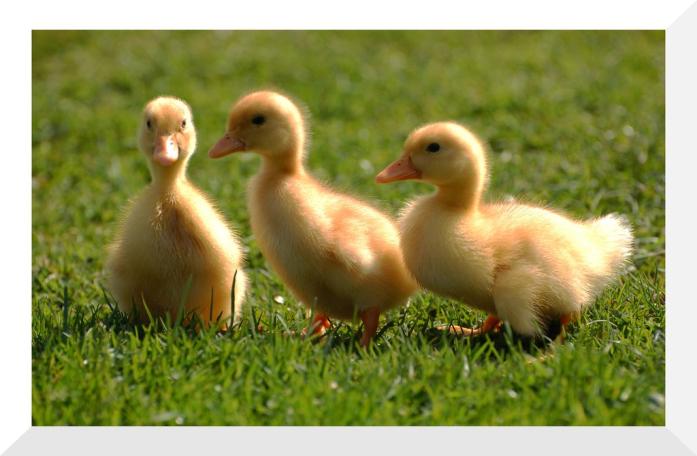
A small group of ducklings can be brooded by a broody chicken hen. If the ducklings aren’t hatched by the hen, the can be placed under her in a confined area at night so that she will readily accept them. A bond will form between the mother and her adopted brood that will last for many weeks.
Ducklings can also be brooded artificially in the same way as baby chicks. Because they grow rapidly, ducklings will need heat a shorter period of time, and floor space requirements will increase more rapidly.
A brooder house, garage or barn corner can be used as a brooding area for small numbers of birds. The brooding area should be dry, reasonably well lighted and ventilated, and free from drafts. Cover the floor with about 4 inches of absorbent litter material, such as wood shavings, chopped straw, or peat moss. Litter dampness is more of a problem with ducks than with chicks. Good litter management will require removal of wet spots and frequent addition of clean, dry litter. Be sure litter is free of mold.
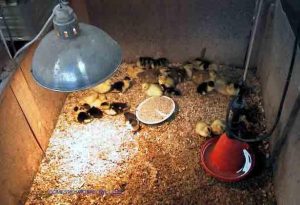
Infrared heat lights are a convenient source of heat for brooding small numbers of birds. Two 125-watt lights, suspended close together, 18 inches from the floor will provide adequate heat and serve as a backup source in the event that one light “burns out” during the night. The temperature at the edge of direct light should be 85-90 degrees F when the ducklings arrive. The heat can be reduced 5-10 degrees per week as the ducklings grow by raising the heat lights, providing more run space, and reducing the number of lights.
Confining the birds to the heated area with a corrugated paper chick guard for the first 3 to 4 days will assure success. Watch the behavior of the birds for signs of discomfort. If they are too hot, they will move away from the heat. If too cold they may pile up and be noisy.
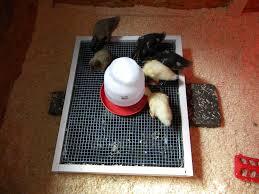
High temperatures may result in slower feathering and growth. Supplementary heat may be needed for 5 to 6 weeks in cold weather; in summer, only 2 to 3 weeks. By 4 weeks of age, the ducklings should be feathered enough to be outdoors except in extremely cold, wet weather.
Allow ½ square foot of floor space per bird during the first two weeks. Increase this to at least 1 square foot by 4 weeks. If the birds are to remain confined after the first month, provide them with at least 2 square feet of floor space.
Feeding Ducks
Ducklings should be started on a commercially produced starter crumble. If duck starter is not available, chick starter can be substituted. Medicated chick starter is not necessary, since ducks are resistant to the diseases that chicks are susceptible to.
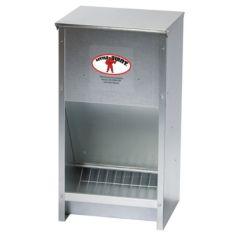
Place crumbles in an egg flat for the first day or so that the ducklings can find the feed, then place the feed in a small chick feeder. Commercial ducklings will consume .5 pounds of feed each in their first week. Keep the feeder some distance from the waterer, preventing the feed from getting wet.
Switch the ducklings to a grower pellet at two weeks of age. A high capacity hopper feeder will provide the volume necessary for the growing period. Ducks must have free-choice feed at all times.
By using quality feed and preventing waste, commercial meat ducks will consume about 20 pounds of feed each by market time.
|
Suggested Macronutrient Requirements of Ducks Peter R. Ferket, Extension Poultry Nutritionist, and Gary S. Davis, Extension Poultry Specialist North Carolina State University |
|||||
| Starter | Grower | Finisher | Breeder2 | ||
| Nutrient | 0-2 weeks | 2-6 weeks | 6-8 weeks | Developer | Layer |
| Metabolizable energy (Kcal/lb.)3 | 1400 | 1400 | 1400 | 1175 | 1300 |
| % Protein | 20.0 | 18.0 | 16.0 | 14.5 | 16.0 |
| % Lysine | 1.1 | 0.9 | 0.8 | 0.65 | 0.75 |
| % Arginine | 1.1 | 1.0 | 0.9 | 0.7 | 0.85 |
| % Methionine + Cystine | 0.9 | 0.8 | 0.7 | 0.6 | 0.65 |
| % Calcium | 0.9 | 0.8 | 0.8 | 0.7 | 2.9 |
| % Available Phosphorus | 0.45 | 0.4 | 0.4 | 0.35 | 0.35 |
| % Linoleic Acid | 1.0 | 1.0 | 1.0 | 0.8 | 1.0 |
Protein is composed of compounds called amino acids. Having the correct amount of each amino acid in the duck’s diet is essential to maximizing growth rate and health. Since your goal is an 8+ pound market duck in just two months, anything less than the ideal ration will restrict growth.
It is noteworthy that egg laying ducks and breeders should be fed a lower energy ration that market ducks. Too much energy will cause the bird to become over-fat and will not produce as many eggs when mature.
Watering Ducks
Ducks are waterfowl and have a natural attraction to water. Keeping fresh water for your birds is essential (and a challenge, since they like to “play in it”). Chick waterers can be used to start ducklings, but they will require greater capacity waters very quickly.
If ducks are to be watered in a pool or small pond, great effort must be taken to insure that the water is fresh and clean many times per day. Also you must be prepared for the mess that will be produced when the birds splash the water out of the pool.
Many simple do-it-yourself duck waterer ideas are available. Waterers that prevent them from swimming in their water or drip nozzles are effective and can be made from simple materials. If kept clean, these devices will insure adequate quality and quantity of water for your ducks and will keep their environment clean and dry.
Duck waterers can be made from simple materials and will serve as a good source of fresh water for your ducks with minimum mess.
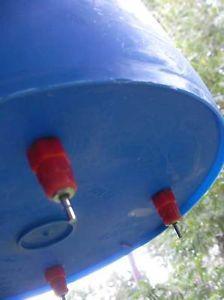

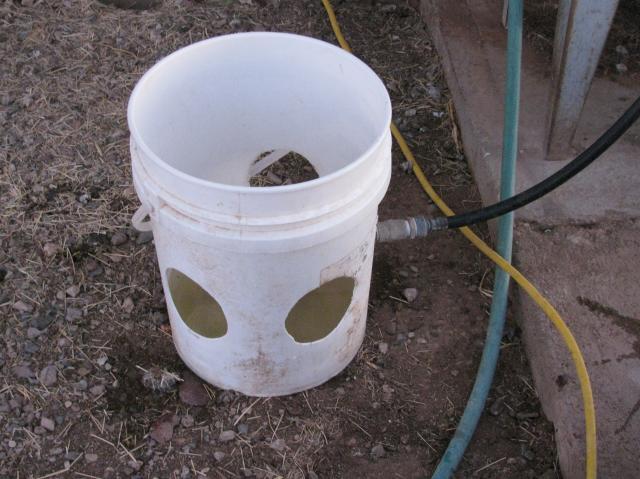
Muscovies as meat ducks
Muscovy ducks are excellent meat ducks and are raised commercially (mostly in France) for their fine quality, dark colored and flavorful meat. They are often raised on general and hobby farms and can command a fair price in specialty markets. Mule ducks (Muscovy male x Pekin female) and, to a lesser extent, Hinny ducks (Pekin male x Muscovy female) are also raised commercially. However, Muscovies and their hybrids, sometimes called Moulards, are not competitive with hybrid Pekins for rate of gain and feed efficiency; therefore they are not recommended for a county fair meat duck competition.
Processing Meat Ducks
State laws regulate the processing of poultry for sale. Though Wisconsin Law does allow for personal use and small sales of home-dressed poultry, extensive sales must be processed in an inspected processing plant.
If you choose to have your ducks custom processed, inspected and packaged for sale, research your area for slaughter plants that will handle this need before you begin your project. Schedule your ducks with the processor well in advance of the date needed. Remember your ducks will be finished in just seven weeks!
Cooperatively processing your ducks with other project members can be very educational and rewarding.

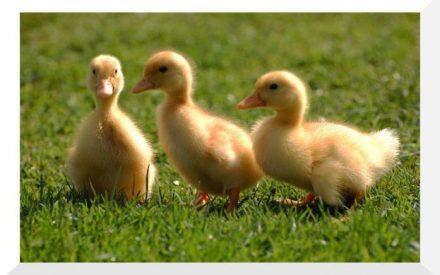 Preparing Ducks for the Fair
Preparing Ducks for the Fair The Origin of Ducks
The Origin of Ducks Finding a Veterinarian for your Chickens
Finding a Veterinarian for your Chickens


